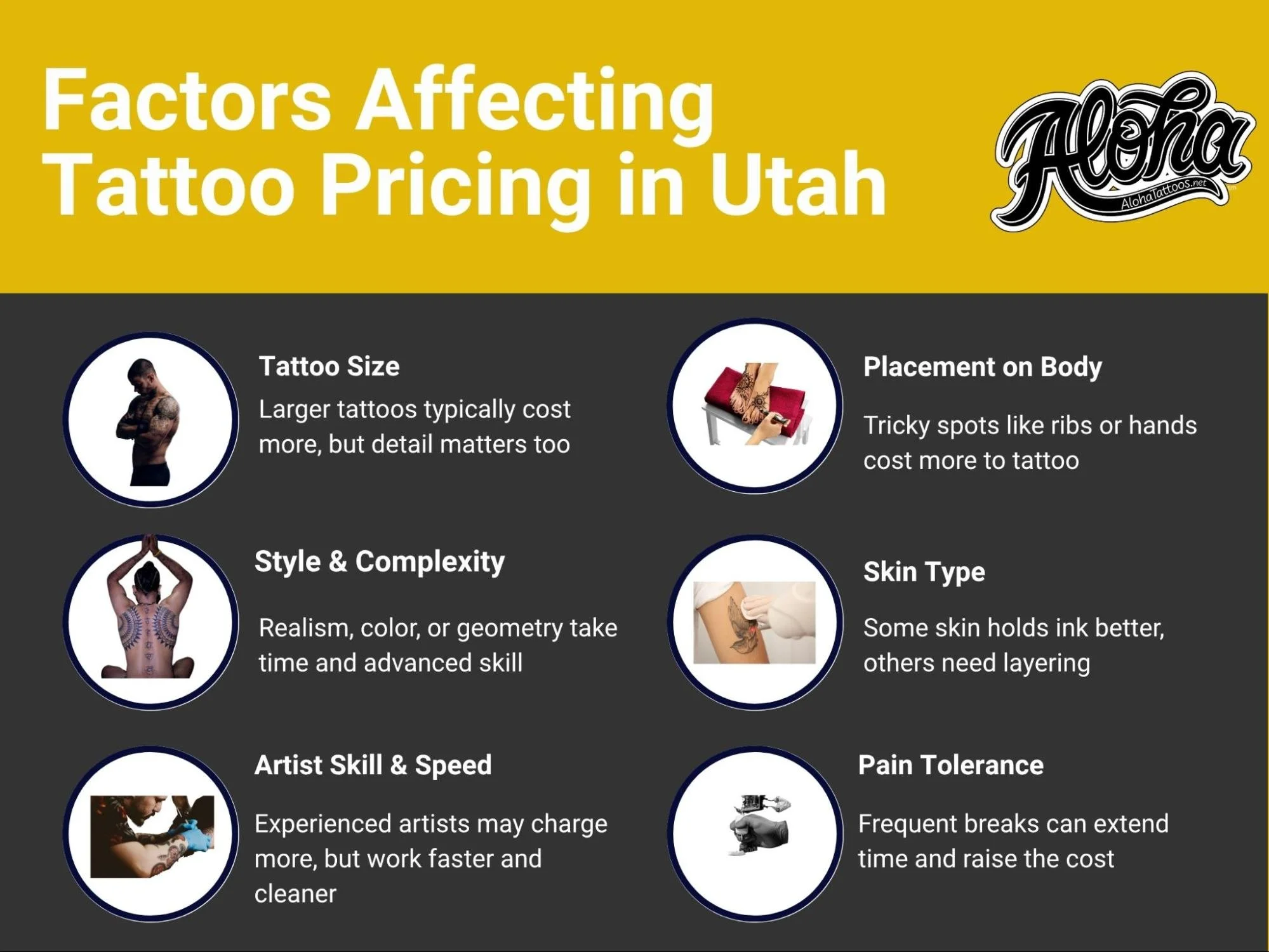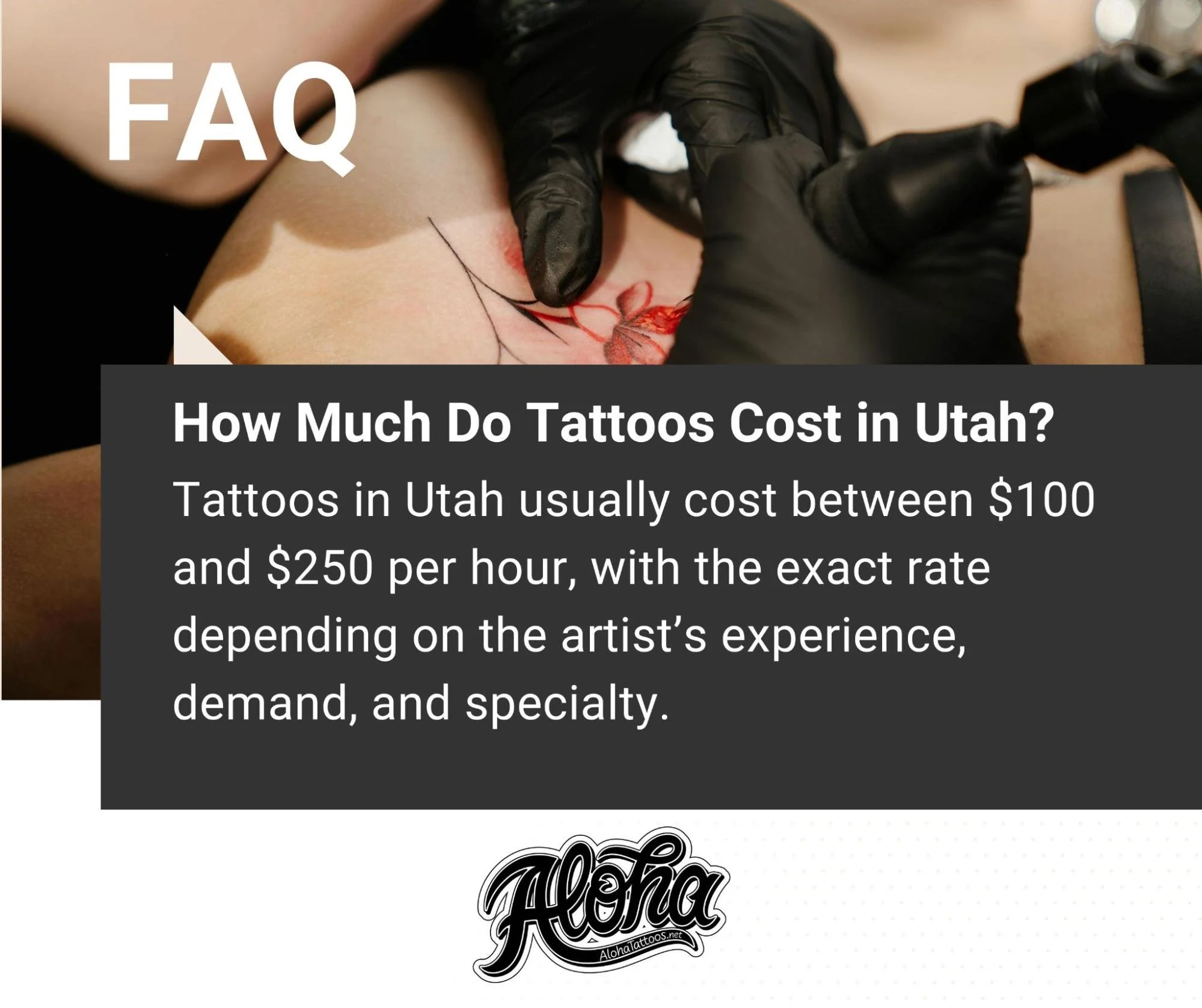How Much Do Tattoos Cost in Utah? A Complete Pricing Guide
Tattoos in Utah generally cost between $100 and $250 an hour, depending on the artist. My shop, Aloha Tattoos, starts most tattoos at $140–$250 per hour, with large custom work priced by the session. Our Price always depends on size, style, and how detailed the piece is.
I’ve been tattooing for over two decades, and I'll walk you through what tattoos cost in Utah, what affects the price, and how to avoid getting burned by vague quotes.
How Tattoo Pricing Works at Most Utah Studios
Most shops (including mine) structure pricing in a few common ways. Let’s understand them first to help you plan smarter and avoid surprises.
Hourly Rates
Several artists in Utah charge between $140 and $250 an hour. The rate reflects the artist’s skill, speed, and the kind of work they’re doing.
A higher hourly price doesn’t always mean you’re paying more overall. Efficient artists get more done in less time, which can save you both time and pain in the chair.
The $200 tattoo that took 30 minutes probably came from someone who’s dialed in their craft and doesn’t waste strokes.
Flat Rates & Session Pricing
This setup gives clients a clearer idea of total cost and helps artists work without watching the clock. We recommend session pricing when a project is large, detailed, or will require multiple sittings. It’s easier to budget, and it allows the art to come together naturally without rushing or breaking it into awkward chunks.
By the Piece
Smaller tattoos, especially flash pieces or simple designs, are often priced per piece. These flat rates depend on the design, placement, and time expected, but it’s key to ask what’s included.
Not all artists bundle design time, setup, or stencil prep into the quote. That is why at Aloha Tattoos, we keep it transparent, so you know exactly what you’re paying for.
Shop Minimums
Almost every shop in Utah, including mine, has a minimum charge. This usually starts around $100 to cover setup, sterilization, and materials, even for tiny tattoos. Some body areas, like hands or ribs, may start a bit higher due to their complexity. These minimums help ensure every tattoo, big or small, meets the same safety and quality standards.
What Affects Tattoo Pricing in Utah
As we said, tattoo prices are based on a mix of technical and artistic factors. These elements can help you plan your budget and avoid surprises when it’s time to book.
1. Tattoo Size
Size definitely plays a role, but it’s not as simple as measuring inches. A small tattoo might fall between $100 and $300, medium pieces usually land in the $400–$800 range, and large work, like sleeves, back pieces, or thigh tattoos, can start around $1,000 and go up from there.
That said, a $500 tattoo might cover a forearm with medium detail or a full calf if the design is simpler. But remember, size doesn’t always equal time. A small, high-detail tattoo can take longer than a medium one that’s more minimal.
2. Style & Complexity
Tattoo style has a huge impact on pricing. Realism, Nordic/Viking, sacred geometry, and full-color pieces take more time and precision than simple line work or flash. These styles also require artists with specific skills, which can raise the hourly rate or session cost. I’ve done everything from bindrunes to layered mandalas, and trust me, some designs demand more mental and physical energy than others.
3. Artist Skill & Speed
Some clients chase lower hourly rates thinking they’ll save money, but end up with artists who move slowly, hesitate, or don’t plan efficiently.
Speed is not about rushing. Mostly, it reflects confidence and clean execution. A faster artist might charge more per hour, but you’ll likely finish quicker, heal better, and avoid costly touch-ups.
4. Placement on the Body
Where you want your tattoo can raise the price. Areas like ribs, necks, feet, and hands are harder to tattoo and take longer to complete. The skin is thinner, more sensitive, and harder to stretch. That means more time, more pain, and a higher minimum. We always talk about placement during consultations so you know what to expect before we start.
5. Skin Type & Pain Tolerance
Everyone’s skin reacts differently to ink. Some skin types hold pigment better, while others take longer or need more layering. If your skin is super sensitive or you have a low pain threshold, breaks might be needed during the session, which can increase time and cost. This is something we discuss in the studio, especially for clients getting their first big piece or going into tricky spots.
Common Fees and Extras You Should Know About
There are a few extras you’ll want to factor into your budget. Some are standard, while others depend on the shop.
Deposits
Studios typically require a deposit to secure your appointment. This ranges from $60 to $200 depending on the artist and complexity of the piece. The deposit goes toward the final cost, but it’s often non-refundable if you cancel too close to the session or don’t show up.
Design Fees for Custom Art
Custom designs take time, skill, and sometimes multiple revisions. Some artists include this work in the overall quote, while others charge separately, if the design is complex or requires hand-drawn elements.
Our artists always explain this upfront. If someone brings in a rough idea, we’ll turn it into something workable.
Touch-Ups
Touch-ups may or may not be included in the initial quote. Some artists offer free touch-ups within a specific timeframe, assuming proper healing. Others charge a reduced rate or full hourly price depending on the reason for the touch-up. So, always ask beforehand.
Aftercare Supplies
Most studios recommend high-quality healing products like medical-grade bandages or ointments. These are often not included in the tattoo price. Skimping on proper aftercare can lead to fading, patchy healing, or even infection, which might require additional sessions.
Tips
Tipping is not required, but it’s standard in the tattoo world. Think of tattoo studios like a restaurant. If you had a great experience, you may want to show your appreciation.
How to Make Sure You’re Not Overpaying (or Getting Junk)
If you're spending your hard-earned cash on permanent artwork, here’s how to make sure the price lines up with the quality.
Avoid shops that cut corners. Dirt-cheap quotes mostly mean dirty practices, like reused needles, low-grade ink, or poor sterilization. These risks are not worth saving a few bucks.
Check the artist’s portfolio. Here, look for healed tattoos, not only fresh ones. A strong portfolio will show clean lines, smooth shading, and consistent quality across different styles.
Ask the right questions. How long have they been tattooing? Are they licensed? What style do they specialize in? Artists who know their craft won’t shy away from answering.
Know what’s included in the price. Ask if your quote includes design time, setup, breaks, and aftercare support. Clarity upfront prevents confusion and surprise charges later.
Focus on value. A $200 tattoo from someone experienced and efficient might look better and heal faster than a $100 one from a rookie. In tattoos, you often get what you pay for, and fixing cheap work usually costs more than doing it right the first time.
Why Cheaper Is Not Always Better for Tattoos
Tattoos are permanent, and saving a few bucks up front can cost you a lot more later. Here's why lower prices, most times, come with trade-offs that are not worth it in the long run.
1. Poor Healing and Fading
Budget studios use cheap ink or rush the process, which leads to uneven saturation and faster fading. A tattoo that looks bold on day one might lose half its sharpness within months.
Proper healing requires both skill and the right tools. These are not guaranteed when you're paying rock-bottom rates.
It can lead to inconsistent healing, so more money from your wallet in the name of more touch-ups.
2. Higher Risk of Infection
Low-cost shops may skip vital safety protocols to save money. That could mean cutting corners on sterilization, reusing supplies, or working in less-than-clean environments.
An infection from a poorly done tattoo is dangerous. You could be looking at antibiotics, scarring, or even hospital visits. That risk alone makes the slightly higher price at a clean, professional studio a no-brainer.
3. Sloppy Work and Design Flaws
Artists offering cut-rate tattoos are often inexperienced or stretched thin trying to hustle quick cash.
And the result is shaky lines, uneven shading, and designs that don’t age well. Once it’s on your skin, bad work is hard, and sometimes impossible, to fix. What seemed like a deal in the moment becomes a daily reminder of a rushed decision.
4. Longer, More Painful Sessions
Cheaper doesn’t only mean less money. Sometimes, it can mean more time in the chair. Inexperienced artists tend to second-guess themselves, take more breaks, and generally work slower. That adds up to longer sessions, more discomfort, and more stress on your body. Time is money, especially when your skin’s on the line. What looks like a cost-saving move might end up costing more in both time and pain.
5. Cover-Ups Are Expensive
Fixing a bad tattoo is emotionally draining and expensive. Cover-ups require more skill, more time, and sometimes can’t fully hide the original work. You might also be limited in what designs will work as a cover, forcing you into something you didn’t originally want. In many cases, it’s cheaper to invest in a solid tattoo upfront than try to salvage bad work later. Once it’s there, you can’t hit undo.
Is a Utah Tattoo Worth It?
Yes, if you know what you’re getting into and choose the right artist. Utah has some incredible talent, from seasoned veterans to rising stars, but like anywhere, it also has its share of shortcuts and quick cash shops.
The key is knowing what drives the cost and recognizing that you’re investing in skill, safety, and something you’ll wear for life.
I’ve been tattooing across the globe for more than 20 years, and I can say with full confidence that price should never be the only thing guiding your decision.
A great tattoo comes from collaboration, trust, and a clear process. In my experience, the people who walk away happiest are the ones who took their time, did their homework, and saw the value in doing it right.
Not Sure What You Can Afford? Let’s Chat
Are you thinking about a piece but not sure how far your budget will go? Book a consultation with Aloha Tattoos and we’ll walk you through it.
We will talk about the tattoo design, placement, timing, and pricing so you know exactly what to expect before the needle hits the skin.






